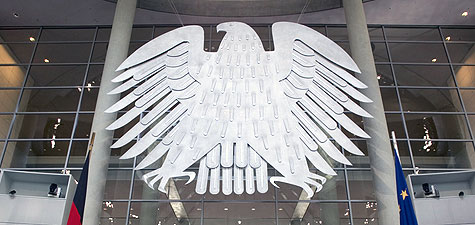Navigationspfad: Homepage > German Bundestag > National symbols
The federal eagle

The Bundestag eagle in the plenary chamber © German Bundestag/ Schüring
The federal coat of arms depicts the single-headed black eagle against a golden background; it has its head turned to the right and wings open, with the feathers not spread; its beak, tongue and talons are red.
The eagle is the emblem of the Federal Republic of Germany.
Even long ago, in the Orient and in Antiquity, amongst the Germanics and the Romans, the eagle was revered in particular as a symbol of the supreme deity, of vitality and of the sun. It became part of the coats of arms of many states and noble houses and also has a long tradition in German history.
Historical roots of the German heraldic eagle
As early as 800 AD, Charlemagne adopted the single-headed eagle as the symbol of imperial power. An illustration in the Bamberg Evangeliar shows Emperor Otto III, holding an eagle-shaped sceptre in 1000 AD.
During the 12th Century, the black eagle against a golden background was generally recognised as the emblem of the Holy Roman Empire.
Around 1200, during the reign of Frederick II, the double-headed first appeared and, from the 15th Century onwards, became the armorial of the Empire. The single-headed eagle, meanwhile, came to symbolise the German Royalty. The double-headed eagle symbolised the Holy Roman Empire until its dissolution in 1806.
The German Confederation founded in 1815 did not initially have its own confederate symbol. In March 1848, the Diet of the German Confederation declared that the "old German imperial eagle" - the double-headed eagle - should form the coat of arms of the German Confederation. In July 1848, the National Assembly in Frankfurt also confirmed the double-headed eagle as the imperial emblem. Even prior to this, the coin issued to mark the opening of the National Assembly on 18 May 1848 in the Paulskirche depicted the double-headed eagle.
In 1871, the Prussian King and German Kaiser Wilhelm I chose the single-headed German royal eagle for the imperial coat of arms of the German Empire (1871-1918). This imperial coat of arms showed a black, single-headed eagle with a red beak, tongue and talons, without a sceptre or imperial orb, with the Prussian eagle on its breastplate and, above its head, the crown of Charlemagne with two intersecting arches.
The eagle after 1918
Likewise, in the Weimar Republic (1918-1933), the single-headed eagle was retained.
A notice issued on 11 November 1919 concerning the imperial coat of arms and the imperial eagle stated:
"On the basis of a decision by the Imperial Government, I hereby proclaim that the imperial coat of arms shall show the single-headed black eagle on a golden background, with its head turned to the right, the wings open and feathers not spread, with beak, tongue and talons depicted in red.
If the imperial eagle is portrayed without a frame, the same picture and the same colours shall be used as for the eagle in the imperial coat of arms, but the tips of the feathers shall be pointed outwards.
The specimens kept at the Reich Ministry of the Interior shall be definitive for the heraldic design of the imperial coat of arms. Minor artistic modifications shall be permissible for any particular purpose, however."
The National Socialists combined the symbol of the eagle with the swastika. A regulation issued in 1936 defined a swastika framed by a wreath of oak leaves, topped by an open-winged and right-facing eagle, as the sovereign symbol of the Reich. The National Socialist Party (NSDAP) also used an eagle as its symbol: though in this case the eagle was facing to the left. The swastika was the dominant symbol during this period.
The eagle after 1945
On 20 January 1950, the Federal Republic of Germany officially introduced the eagle as the German coat of arms. The notice issued in 1919 was modified only slightly, to replace "imperial eagle" with "federal eagle" and "imperial coat of arms" with "federal coat of arms".
As was the case in the Weimar Republic, minor artistic modifications were allowed for particular purposes. The directives issued by the Federal Minister of the Interior in 1950, which distinguish between "documentary" and "decorative" purposes, note that any person is entitled to use the federal eagle for artistic purposes.
Thus, the federal eagle is portrayed differently on coins, stamps and letterheads, for example. In 1953, the artist Ludwig Gies, from Cologne, was commissioned by the German Bundestag to design a Bundestag eagle for its plenary chamber in Bonn. Today, the eagle designed by Gies can still be seen in the Bundestag's plenary chamber in the Reichstag Building in Berlin, though it was revamped in 1999 by the Lais studio.
Official depictions of the federal eagle can be seen on the federal coat of arms, the Federal Institutions Flag, along with the standards of the Federal President and official stamps and seals.
In the German Democratic Republic (GDR), the eagle was not part of the state coat of arms. The GDR's coat of arms was defined as "a hammer and compasses, framed by a wreath of grain ears, with a ribbon of black, red and gold wound around the bottom section".
Since reunification in 1990, the federal eagle has once again been the emblem of the whole of Germany.

